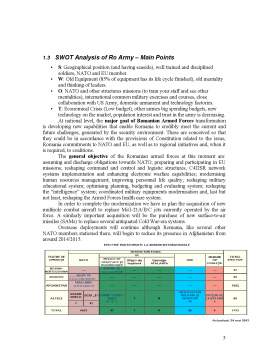Cuprins
- Directory 2
- 1 ROMANIAN ARMY 3
- 1.1 Brief historical facts 3
- 1.2 Romanian Army today 4
- 1.3 SWOT Analysis of Ro Army – Main Points 5
- 1.4 Land Forces Equipment 6
- 1.5 Air Force Equipment 7
- 1.6 Naval Forces Equipment 7
- 2 AUSTRIAN ARMED FORCES 8
- 2.1 Brief historical facts 8
- 2.2 The Austrian Armed Forces today 9
- 2.3 Abroad missions of the Austrian Armed Forces 10
- 2.4 Future perspectives 11
- 2.5 Equipment of the Austrian Armed Forces (AAF) 11
- 2.6 Structure 12
- 2.7 Organisations of the AAF 13
- 3 CONCLUSIONS 13
- 4 REFERENCES 14
Extras din proiect
1 ROMANIAN ARMY
1.1 Brief historical facts
The Romanian Army entered the World War I late, the Romanian government signing a treaty with the Allies on August 17 1916, and declaring war on the Central Powers on August 27. The Romanian campaign was part of the Balkan theatre of World War I, fighting along with Russia against the armies of the Central Powers. Romania entered the war in an attempt to seize Transylvania, a historical province of Hungary with a majority-Romanian population. After several defensive victories in 1917, the Allied front collapsed when the Bolsheviks took Russia out of the war and Romania, left surrounded by the Central Powers, signed an armistice at Focşani. On November 10, 1918, just one day before the German armistice and when all the other Central Powers had already capitulated, Romania belatedly re-entered the war and seized Transylvania.
In World War II, following the outbreak on 1 September 1939, the Kingdom of Romania under King Carol II officially adopted a position of neutrality. But, in the summer of 1940, a series of territorial disputes were resolved unfavourably for Romania, resulting in the loss of most of the territory gained in the wake of World War I. This caused the popularity of Romania's government to plummet, who had eventually staged a coup that turned the country into a fascist dictatorship under Marshal Ion Antonescu. The new regime firmly set the country on a course towards the Axis camp, officially joining the Axis Powers on 23 November 1940. "When it's a question of action against the Slavs, you can always count on Romania," Antonescu stated ten days before the start of Operation Barbarossa.
On 23 August 1944, just as the Red Army was penetrating the Moldavian front, King Michael I of Romania led a successful coup with support from opposition politicians and the army. Michael I was able to successfully depose the Antonescu dictatorship and immediately declared war on Germany on the night of 23 August 1944. Under the 1947 Treaty of Paris, the Allies did not acknowledge Romania as a co-belligerent nation (winning nation) and Northern Transylvania was recognized as a part of Romania, but the border with the USSR was fixed at its state on January 1941, so Romania lost territory to Ukraine and Republic of Moldavia.
In Romania proper, Soviet occupation following World War II facilitated the rise of the Communist Party as the main political force, leading ultimately to the forced abdication of the King and the establishment of a single-party people's republic in 1947.
The Romanian Revolution was a series of riots and protests in Romania in December 1989. These were part of the Revolutions of 1989 that occurred in several Warsaw Pact countries. The Revolution marked the end of the Communist regime and the death of Nicolae and Elena Ceauşescu. The Revolution caused 1,104 deaths, 162 of these occurring in the protests that took place from 16 to 22 December 1989 and brought an end to the Ceauşescu regime and the remaining 942 in the riots before the seizure of power by a new political structure, the National Salvation Front.
Other important moments in Romanian Army history are:
• 14 December 1955 – Romania joined United Nations;
• 25 June 1973 – Admission in OSCE (in 2001 Romanian Presidency of OSCE);
• 2 April 2004 – Romania joined NATO;
• 1 January 2007 – Romania became an EU member.
1.2 Romanian Army today
Romania joined NATO in 2004. As a consequence we had to create a professional army and to abolish conscription by 2007. Today, 90,000 men and women currently comprise the Armed Forces, 75,000 of them being military personnel and the other 15,000 civilians. The 75,000 military personnel is divided between 60,000 active troops and 15,000 active territorial reserves. As of 2010, the Land Forces have a reported strength of 43,000, the Air Force 9,700, the Naval Forces 7,150, and Joint Forces 13,500. As per the 2011 White Paper, these forces are to be gradually decreased by 2015, to reach a total of approximately. 65,000 active troops and active reserves. Total defence spending currently accounts for 1.33% of total national GDP, which represents approximately 1.78 billion euro (ranked 54th).
1.3 SWOT Analysis of Ro Army – Main Points
• S: Geographical position (and having seaside), well trained and disciplined soldiers, NATO and EU member.
• W: Old Equipment (85% of equipment has its life cycle finished), old mentality and thinking of leaders.
• O: NATO and other structures missions (to train your staff and see other mentalities), international common military exercises and courses, close collaboration with US Army, domestic armament and technology factories.
• T: Economical Crisis (Low budget), other armies big spending budgets, new technology on the market, population interest and trust in the army is decreasing.
At national level, the major goal of Romanian Armed Forces transformation is developing new capabilities that enable Romania to credibly meet the current and future challenges, generated by the security environment. These are conceived so that they could be in accordance with the provisions of Constitution related to the issue, Romania commitments to NATO and EU, as well as to regional initiatives and, when it is required, to coalitions.
Preview document
Conținut arhivă zip
- Comparison of Austrian and Romanian Defence System.doc






















